Slipper guitar, that is.
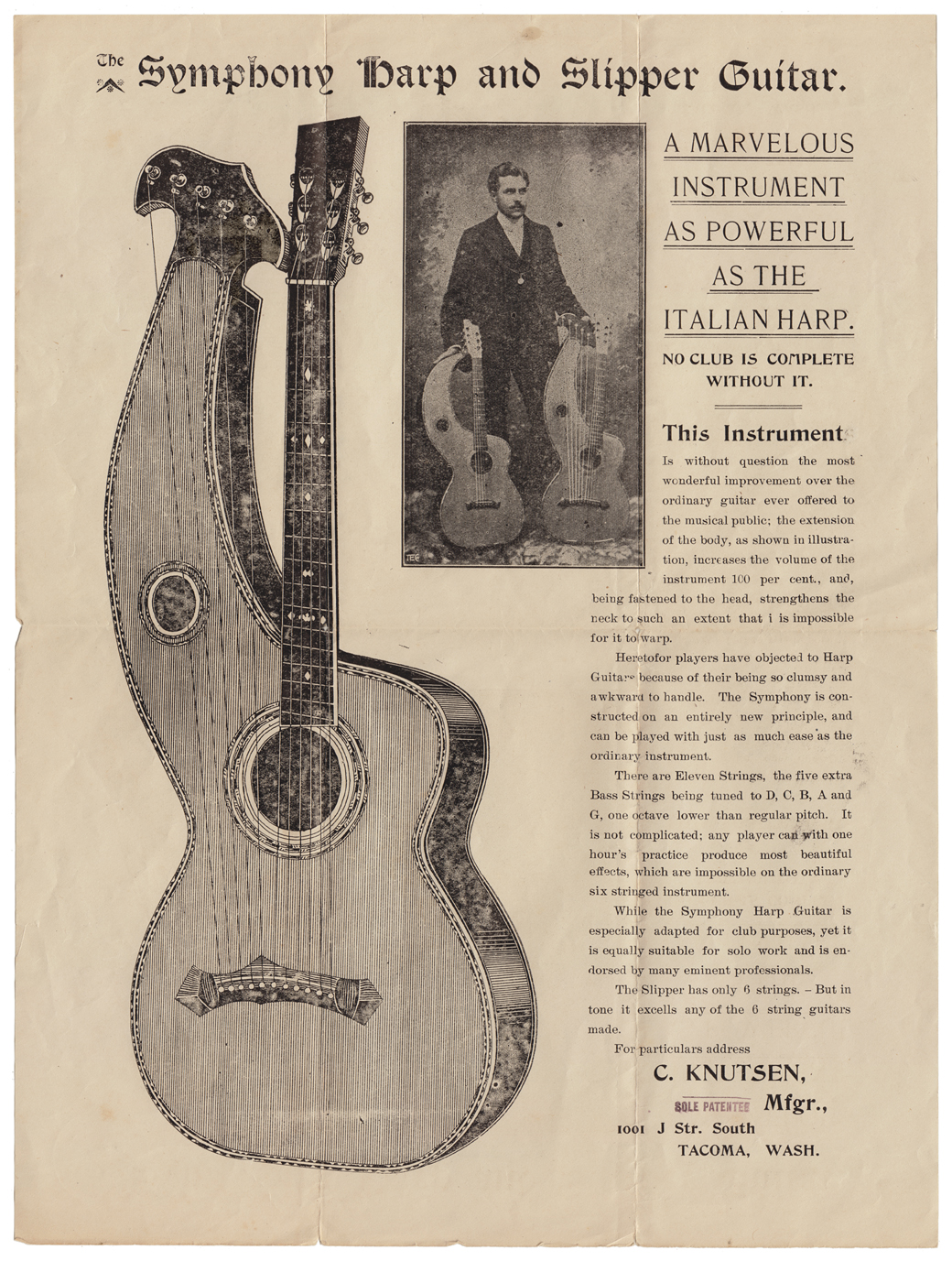
I surreptitiously snagged this off eBay last September – a rare Chris Knutsen advertising circular! It’s a single-sided flyer measuring ~10 by 13” that we can date to c.1900-1902 from Knutsen’s address printed on it: 1001 J. Street South, Tacoma, Wash.
Its unusual title announces “The Symphony Harp and Slipper Guitar.”
We all know what Knutsen’s Symphony harp guitar is (shown in the large woodcut and far right in the photograph), but I’d never heard of a “slipper” guitar (!). It seems that’s what Chris must have decided to call his original hollow arm 6-string for its “last gasp” year of production.
As you might recall, this design was called simply “Guitar” in Knutsen’s 1896 patent. Later he would refer to it as the “One-Arm Guitar,” One-Arm Harp Guitar” or “Short Arm Guitar.” Then maybe one day he saw one lying on its bass side and thought it looked more like a Persian slipper than a harp.
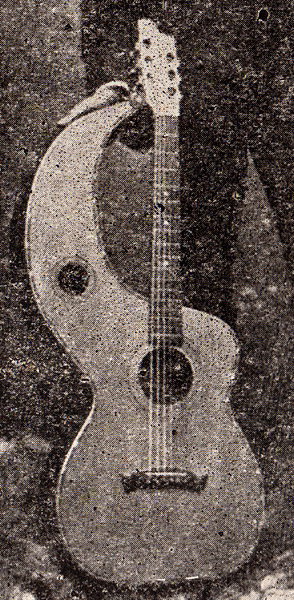
It’s an interesting specimen the male model is holding (we’ll get back to him) – one I don’t yet have in the Archives. It’s certainly the fanciest in trim – none of the previously known 6-strings have much, if anything, in the way of top decoration. It also has a unique bridge that hints at the style and shape of the 11-string Symphony bridge (which would evolve into something else the following year).
Alas, the cute new name for his short-lived six-string guitar is about the only new piece of Knutsenania this flyer reveals. It confirms the time period of this style of Symphony harp guitar, which we already knew; the bridge and arm/head shapes point to the c.1900-1902 time frame. The photographed specimen has simple dot fret markers, while the woodcut sample has fancy fret markers. It’s hard to tell – the photographed Symphony instrument may have Knutsen’s just-introduced “slanted fret” system (subtlety slanted, not biased as in fan fret guitars)…but I don’t know what the engraver was trying to illustrate with his weird fingerboard termination on the woodcut.
It’s interesting to note that the two photographed instruments appear to have been built at the same time; both have the exact same fancy purfling and the asymmetrical headstocks with the offset “gouged trough” tuning machine “slots.” The woodcut shows similar slots but on a square head.
Knutsen’s claim that the neck being fastened to the arm “strengthens the neck to such an extent that it is impossible for it to warp” is of course just wishful thinking; the necks end up twisting instead! I’m also curious as to which maker’s harp guitars he was referring to as being “so clumsy and awkward to handle.”

The reason I held off on posting this was to wait for Jean Cammon Findlay (Knutsen’s relative and biographer) to try to I.D. our mystery gentleman – which she thinks she has done! She first exhausted all known options: He probably wasn’t either of the future husbands of Knutsen’s daughters Evaulda and Bertha (Tom Rousseau and James Pickles, respectively, both around 17 at this time). Nor did he match any pictures Jean was aware of, including Chris’ brother Frank; nor did he look “Scandinavian” enough (i.e. blond) to be a Cammon. The only remaining candidate was Chris Knutsen’s brother Eddie, who she knew was in Tacoma circa 1900. And so (refer to this Knutsen family tree):
“I dug out the picture I have of the Cammon family taken circa 1905-06, probably in Minneapolis. The family had a portrait done of Bergitte (Knutsen’s mother) and all her living children and their spouses (except Eddie’s wife Lillian, m. 1903): in the back row are Mayme and Frank, Winnie (but not Arthur–can’t tell if he is taking the picture or maybe he wasn’t home) and Chris (Knutsen). In front, seated, are Lyle and Margaret (Mayme and Frank’s children), then Bergitte, Eddie, Marie (Marie m. Sep 1906, and her fiancé/husband Emil is not present), and Anna who is in front of Chris and holding Myrtle on her lap.
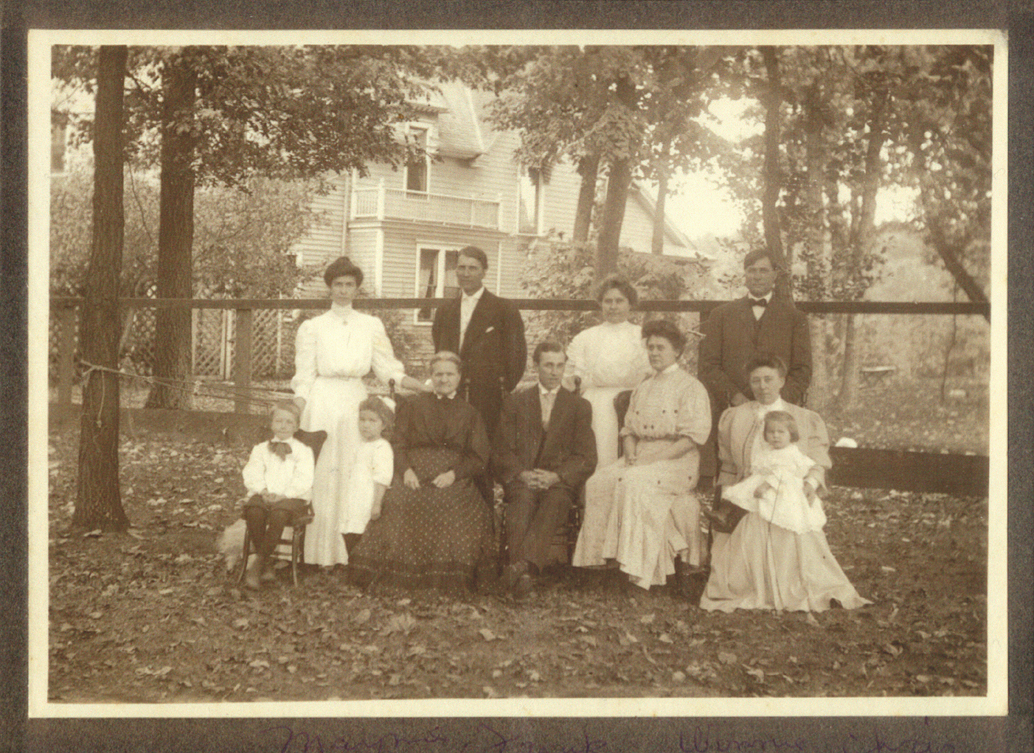
“I had to get out a magnifying glass to examine Eddie. In the family portrait, there is no mustache, but he is holding his head in the same position as the fellow in the flyer. This allows us to see his nose, hairline, eyes, etc., and I would like to say the ear, but the family portrait picture is just too small. Otherwise, I would swear Eddie is even wearing the same suit as in the flyer. The hairline is exactly the same. The eyebrows are equally right down over the eyes. The chin appears to be the same shape. I would say without a doubt this is Eddie in the flyer.
“Eddie is listed in the Tacoma City Directory for 1901 as a boat builder working for Andrew Foss (actually, Andrew’s wife Thea ran the business). At the time, the Foss’s were building rowboats and had not yet started their tugboat empire. His address is listed as at the foot of 11th St. I have read that the Foss family boarded the boys who worked for them, and this is where their business was. Chris lived (from the same directory) at 1001 So J street in Tacoma. This would be about 9 blocks (hard to tell because today the alleys are paved and are streets, too), but it looks like about a mile up from the waterfront (to the west) and then one block north along J St to Chris’s place. I hope there was a tram to catch because that hill is really steep!
“Given the timing – i.e. the date of the flyer and Eddie’s presence in Tacoma about that time–I think the resemblance from the individual in one picture to the other is more than coincidental. It makes sense that Eddie and Chris (as well as Frank), who all appear to have been close, should help each other out. We can eliminate Frank because his face is a little wider, the eyes are different, his hair does not wave in the same way, and he is not so drop dead handsome as Eddie.”
Jean also added that Eddie’s acting and musical instrument playing in high school (no instrument was ever mentioned) was often commented on in the local paper.
Just think of the comments had he brought a Slipper Guitar to school.

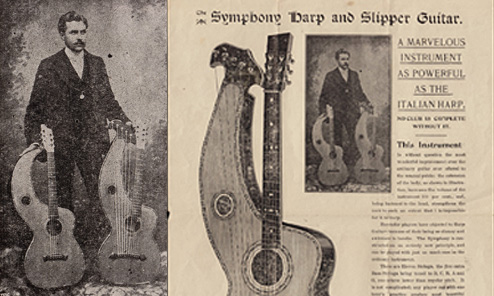
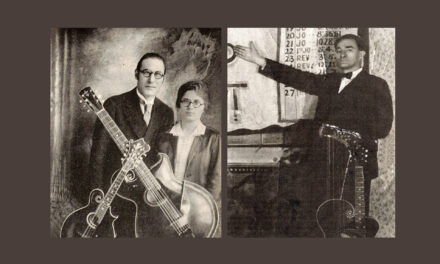

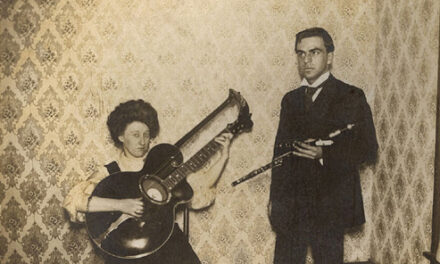
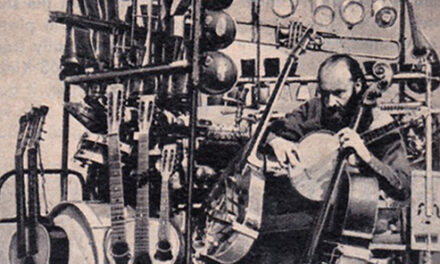
Hello Gregg, great find, great work. To me I’d say the the harp guitar has slanted frets, the frets look like they are angled and the saddle in the bridge seems to tip down. The frets on the slipper guitar (lovely name) look straight, except for the first fret that looks out of place. Looking forward to seeing more of your hidden treasures.
Best wishes .Sean